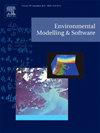AI-driven forecasting of harmful algal blooms in Persian Gulf and Gulf of Oman using remote sensing
IF 4.8
2区 环境科学与生态学
Q1 COMPUTER SCIENCE, INTERDISCIPLINARY APPLICATIONS
引用次数: 0
Abstract
This study develops an artificial intelligence (AI) model to forecast harmful algal blooms (HABs) in the Persian Gulf and Gulf of Oman using freely available remote sensing data, including chlorophyll-a (Chl-a), sea surface temperature (SST), salinity, and wind. The model introduces novel features such as spatial and temporal standard deviations of Chl-a concentration and a derived gradient feature. Correlation analysis indicated that these features enhance predictive capability. A multi-layer artificial neural network (ANN) was trained using a 66%/34% data split for training and testing, achieving 88.7% accuracy in binary classification (bloom/non-bloom) with an area under the ROC curve (AUC) of 90.1%. Overfitting was mitigated by monitoring training and validation loss, both of which consistently decreased over epochs, confirming robust model generalization. The use of standard deviation in SST and salinity highlights their influence on bloom dynamics, providing key insights into algal bloom drivers. The focus on freely available data enables stakeholders to better manage the environmental challenges posed by HABs.
人工智能驱动的波斯湾和阿曼湾有害藻华遥感预测
本研究开发了一个人工智能(AI)模型,利用可免费获得的遥感数据,包括叶绿素-a (Chl-a)、海面温度(SST)、盐度和风,预测波斯湾和阿曼湾的有害藻华(HABs)。该模型引入了新的特征,如Chl-a浓度的时空标准偏差和衍生的梯度特征。相关分析表明,这些特征增强了预测能力。采用66%/34%的数据分割率训练多层人工神经网络(ANN)进行训练和测试,二元分类(开花/不开花)准确率达到88.7%,ROC曲线下面积(AUC)为90.1%。通过监测训练和验证损失来减轻过拟合,两者都随着时间的推移而持续下降,证实了模型的鲁棒泛化。使用海温和盐度的标准差强调了它们对水华动态的影响,为了解藻华驱动因素提供了关键见解。将重点放在可免费获得的数据上,使利益攸关方能够更好地管理有害藻华带来的环境挑战。
本文章由计算机程序翻译,如有差异,请以英文原文为准。
求助全文
约1分钟内获得全文
求助全文
来源期刊

Environmental Modelling & Software
工程技术-工程:环境
CiteScore
9.30
自引率
8.20%
发文量
241
审稿时长
60 days
期刊介绍:
Environmental Modelling & Software publishes contributions, in the form of research articles, reviews and short communications, on recent advances in environmental modelling and/or software. The aim is to improve our capacity to represent, understand, predict or manage the behaviour of environmental systems at all practical scales, and to communicate those improvements to a wide scientific and professional audience.
 求助内容:
求助内容: 应助结果提醒方式:
应助结果提醒方式:


